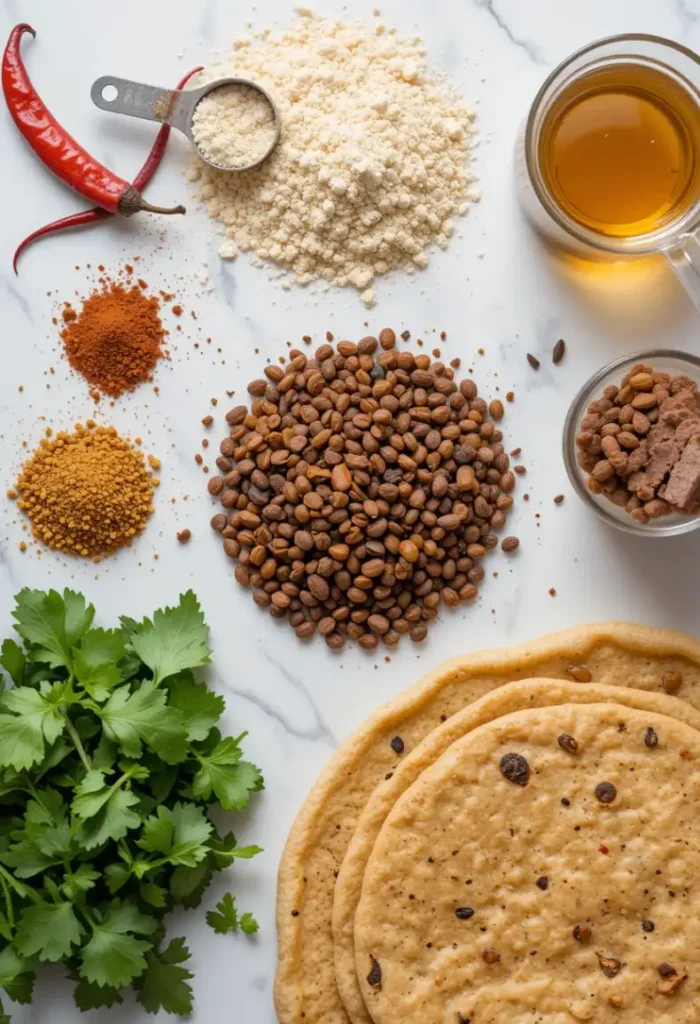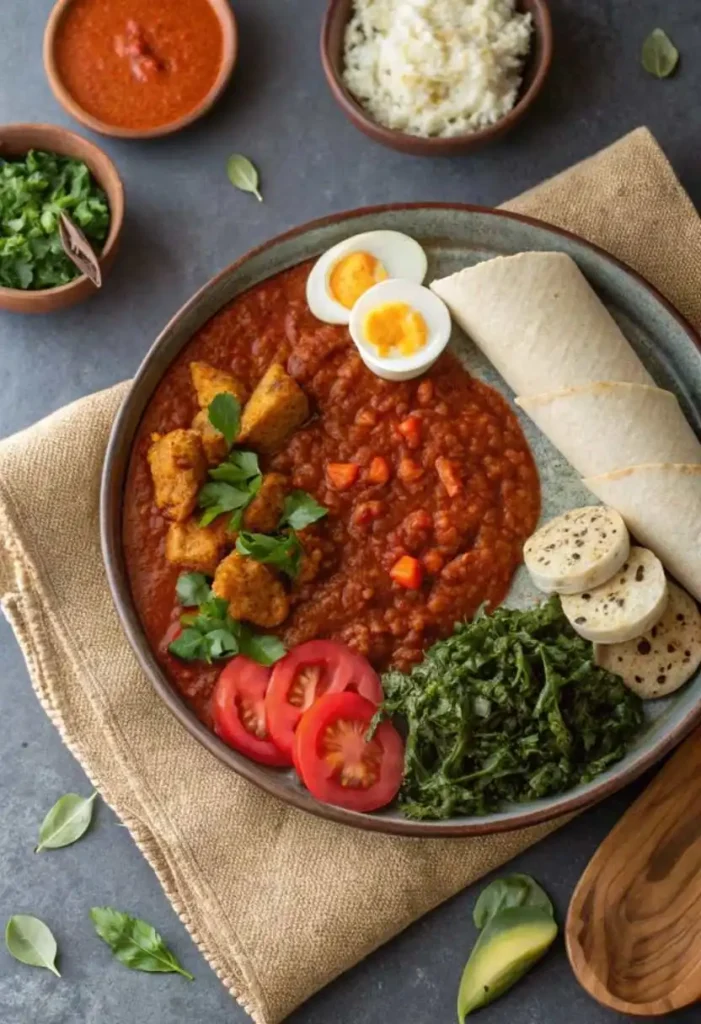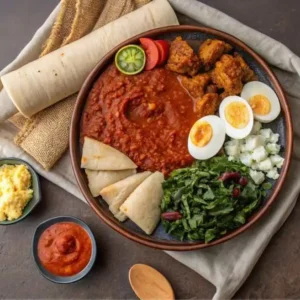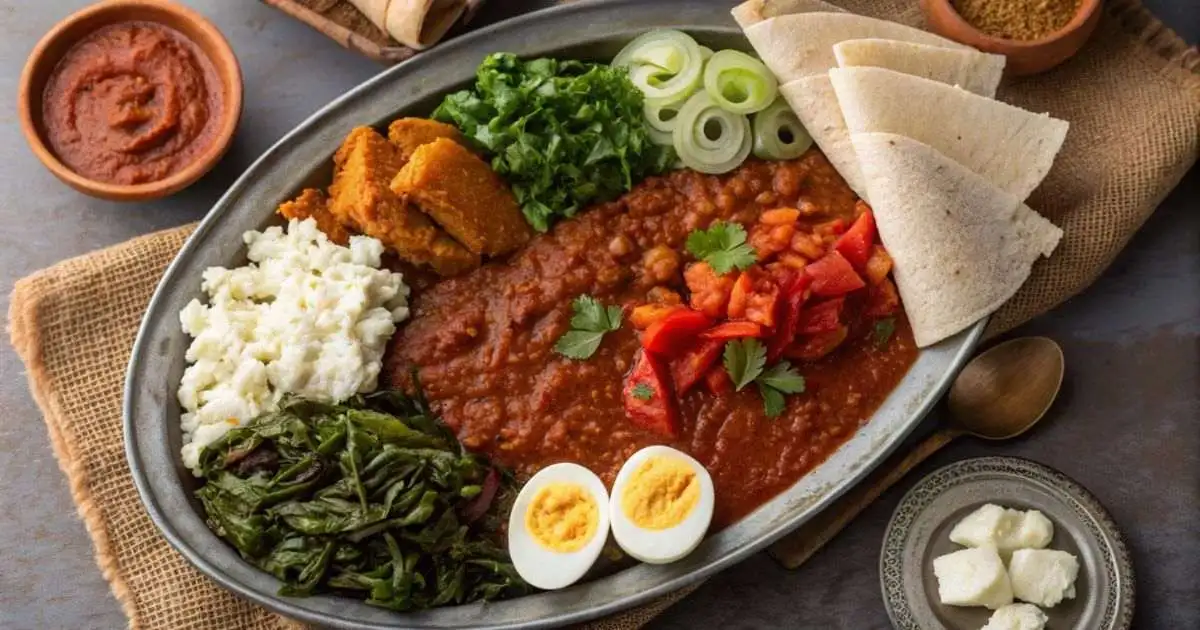Habesha food, the heart of Ethiopian cuisine, is known for its bold flavors, aromatic spices, and communal dining style. Traditional Ethiopian dishes often feature slow-cooked stews (wats), fermented flatbread (injera), and rich spice blends like berbere and mitmita. Whether you’re new to Ethiopian cooking or looking to perfect your techniques, this guide will walk you through authentic Habesha recipes, their benefits, and expert tips for the best results.
Table of Contents
Table of Contents
Why habesha food recipes Nourishes Body and Soul
Habesha food isn’t just delicious—it’s nutritious and culturally significant. Here’s why you should try these recipes:
- Rich in Protein & Fiber: Lentils, chickpeas, and lean meats are staples in Ethiopian cooking.
- Fermented Goodness: Injera, made from teff flour, is naturally gluten-free and gut-friendly.
- Spice-Packed Flavors: Berbere and mitmita add depth while offering potential health benefits from ingredients like turmeric and fenugreek.
- Communal Dining: Encourages shared meals, enhancing social connections.
Essential Ingredients for Authentic Habesha Cooking
For a classic Misir Wot (Red Lentil Stew), you’ll need:

- 2 cups red lentils, rinsed
- 1 large red onion, finely chopped
- 3 tbsp berbere spice (adjust for heat)
- 3 cloves garlic, minced
- 1 tbsp ginger, grated
- 3 tbsp niter kibbeh (spiced clarified butter) or olive oil
- 4 cups vegetable broth
- 1 tsp salt
- Juice of 1 lime
For Injera:
- 2 cups teff flour
- 3 cups water
- 1/2 tsp salt
- 1/4 tsp active dry yeast (optional, for faster fermentation)
Step-by-Step: Mastering Classic habesha food recipes
Misir Wot (Red Lentil Stew)
- Sauté Aromatics: Heat niter kibbeh in a pot. Add onions, garlic, and ginger. Cook until golden (5 mins).
- Add Spices: Stir in berbere and salt, cooking for 1 minute to release flavors.
- Simmer Lentils: Add lentils and broth. Bring to a boil, then reduce heat. Cover and simmer for 25–30 mins until lentils are soft.
- Finish: Stir in lime juice. Adjust thickness with water if needed.
Injera
- Mix Batter: Combine teff flour, water, and salt. Cover and ferment for 2–3 days (or 24 hours with yeast).
- Cook: Heat a nonstick skillet. Pour batter in a circular motion, cooking until bubbles form (2 mins). Do not flip.
Chef’s Secrets: Elevating Your Habesha Dishes
Mastering Habesha food is all about balancing flavors and adapting techniques to suit your taste. Here are expert tips and creative twists to elevate your Ethiopian cooking:
Spice Adjustments
- For Milder Dishes: Reduce berbere by half and replace with sweet paprika for color without excessive heat.
- Extra Spice Kick: Add 1 tsp mitmita (Ethiopian chili powder) or a pinch of cayenne to stews.
- Toasted Spices: Dry-roast whole spices (cumin, cardamom) before grinding for deeper flavor in homemade berbere.
Dietary Variations
- Vegan-Friendly: Swap niter kibbeh with coconut oil or vegan butter infused with garlic and ginger.
- Protein Boost: Add chickpeas or chopped mushrooms to lentil stews for extra texture.
- Gluten-Free: Ensure teff flour is 100% pure (no wheat blends) for authentic injera.
Injera Hacks
- Quick Fermentation: Add 1/4 tsp baking soda to the batter for a faster rise (though flavor will be less tangy).
- Crispier Edges: Use a nonstick skillet on medium-high heat and thin the batter slightly with water.
- No Teff? Substitute sorghum flour, but expect a denser texture.
Texture & Flavor Tweaks
- Creamier Stews: Blend half the cooked lentils and stir back into the pot for a thicker misir wot.
- Umami Boost: Add 1 tbsp tomato paste or soy sauce to stews for richness (not traditional but tasty).
- Herb Garnish: Top dishes with fresh cilantro or basil for brightness.
Regional Twists
- Tigray Style: Simmer stews with korerima (Ethiopian black cardamom) for a smoky note.
- Eritrean Influence: Use hilbet (fenugreek paste) in lentil dishes for a slightly bitter, complex taste.
The Art of Ethiopian Dining: Presentation & Pairings
Ethiopian dining is as much about presentation as it is about flavor. Here’s how to serve Habesha food authentically and creatively:

Traditional Ethiopian Style
- Injera as the Base: Line a large platter or mesob (traditional woven basket) with injera, then spoon stews like misir wot or doro wat on top.
- Communal Dining: Place the platter at the center of the table for everyone to share—eating with hands is encouraged!
- Side Dishes: Include small bowls of:
- Gomen (spiced collard greens)
- Azifa (lentil salad with mustard dressing)
- Ayib (Ethiopian cottage cheese) to balance spicy flavors
Modern Twists
- Injera Tacos: Use small pieces of injera as wraps for stews or grilled meats.
- Bowls: Layer torn injera at the bottom of a bowl, then add lentils, veggies, and a dollop of berbere-spiced yogurt.
- Fusion Appetizers: Roll injera with hummus or avocado for a quick bite.
Beverage Pairings
- Tej (honey wine) – Sweet and floral, perfect with spicy stews.
- Spiced Coffee – Serve after the meal with popcorn (a traditional Ethiopian snack).
- Shai (Tea) – Brew with cinnamon and cloves to complement rich flavors.
For Special Occasions
- Coffee Ceremony: Complete the meal with freshly roasted Ethiopian coffee, served with incense for a full cultural experience.
- Holiday Spreads: Add tibs (sautéed meat) and kitfo (spiced minced beef) for festive gatherings.
Keeping It Fresh: Habesha Food Storage Guide
- Refrigerate: Stews keep for 3–4 days; injera lasts 2 days (wrap in cloth to prevent drying).
- Freeze: Stews freeze well for 2 months. Thaw overnight before reheating.
- Reheat: Warm stews on low heat with a splash of water. Refresh injera in a steamer or microwave briefly.
________________________________________________________

Habesha Food Recipes
Ingredients
- 2 cups red lentils rinsed
- 1 large red onion finely chopped
- 3 tbsp berbere spice adjust for heat
- 3 cloves garlic minced
- 1 tbsp ginger grated
- 3 tbsp niter kibbeh spiced clarified butter or olive oil
- 4 cups vegetable broth
- 1 tsp salt
- Juice of 1 lime
For Injera:
- 2 cups teff flour
- 3 cups water
- ½ tsp salt
- ¼ tsp active dry yeast optional, for faster fermentation
Instructions
Misir Wot (Red Lentil Stew)
- Sauté Aromatics: Heat niter kibbeh in a pot. Add onions, garlic, and ginger. Cook until golden (5 mins).
- Add Spices: Stir in berbere and salt, cooking for 1 minute to release flavors.
- Simmer Lentils: Add lentils and broth. Bring to a boil, then reduce heat. Cover and simmer for 25–30 mins until lentils are soft.
- Finish: Stir in lime juice. Adjust thickness with water if needed.
Injera
- Mix Batter: Combine teff flour, water, and salt. Cover and ferment for 2–3 days (or 24 hours with yeast).
- Cook: Heat a nonstick skillet. Pour batter in a circular motion, cooking until bubbles form (2 mins). Do not flip.
Notes
| Nutrient | Amount |
| Calories | 320 kcal |
| Fat | 9 g |
| Saturated Fat | 2.5 g |
| Carbohydrates | 38 g |
| Fiber | 14 g |
| Sugars | 4 g |
| Protein | 18 g |
| Sodium | 620 mg |
Bringing Ethiopia’s Culinary Heritage to Your Table
Habesha food celebrates Ethiopia’s rich culinary heritage with vibrant spices, wholesome ingredients, and communal joy. Whether you’re making misir wot or mastering injera, these recipes bring authentic flavors to your kitchen.
FAQs
What is the most popular food in Ethiopia?
Injera with doro wat (spicy chicken stew) is widely loved.
What is the national dish of Ethiopia?
Doro wat, a berbere-spiced chicken stew, is considered Ethiopia’s national dish.
What is bula habesha food?
Bula refers to kocho, a fermented bread made from enset (false banana) pulp, common in southern Ethiopia.
What is Dulet Ethiopian food?
Dulet is a spicy mix of minced tripe, liver, and meat, often eaten for breakfast.
How is bula made?
Enset pulp is fermented for months, then kneaded and baked into flatbread.

